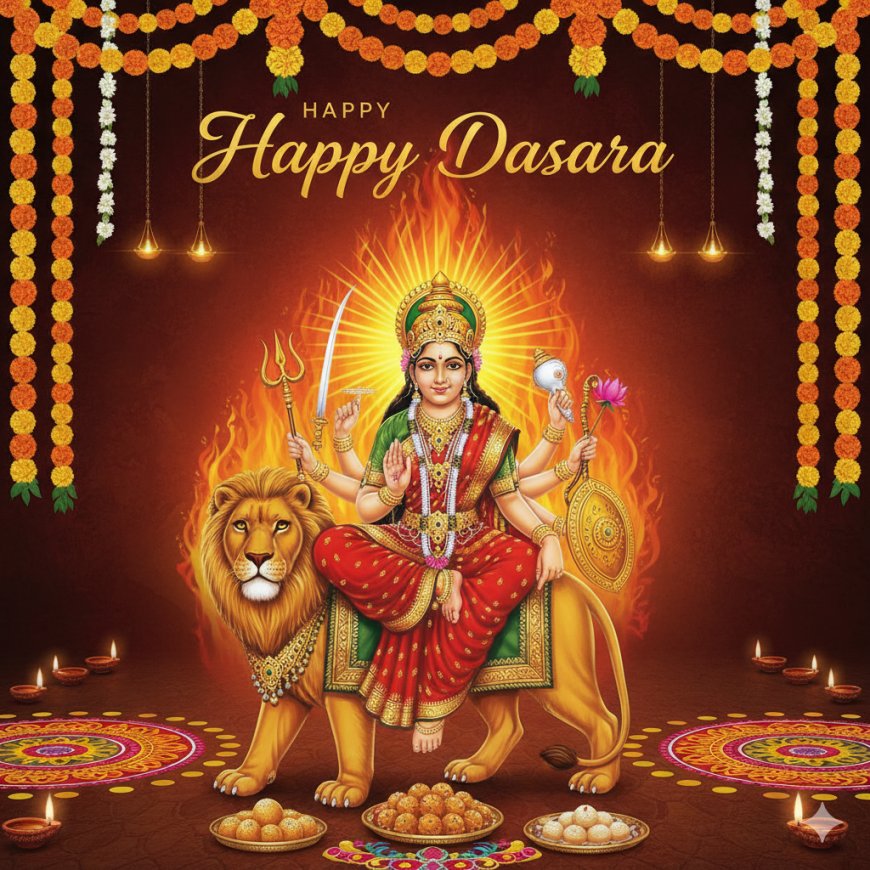Shardiya Navratri 2025 Begins September 22 with Worship of Maa Shailputri
Shardiya Navratri 2025 starts Sept 22 with Maa Shailputri’s worship and ends Oct 2 with Vijayadashami. A festival of devotion, strength & culture.

Introduction
Shardiya Navratri is one of the most important Hindu festivals. It is a nine‐night (and ten‐day, if you include Vijayadashami) festival devoted to worship of Goddess Durga and her nine forms (Navadurga). In 2025, Shardiya Navratri begins on Monday, September 22, with the first day dedicated to Maa Shailputri, and ends with Vijayadashami (Dussehra) on Thursday, October 2.
History and Background
-
The word Navratri comes from Sanskrit: nava (nine) + ratri (night). The festival occurs during the bright (Shukla) half of the lunar month of Ashwin, which falls in September/October. This is called Sharad/Ashwin Navratri (Shardiya Navratri).
-
It is connected to the worship of Goddess Durga in her many forms, and celebrates the victory of good over evil. Many legends are associated: one of the most popular is Durga’s battle with Mahishasura. The festival also links with agrarian cycles (harvest season) and seasonal change — the arrival of autumn (sharad).
-
The ritual of Ghatasthapana (Kalash installation) inaugurates the festival. It symbolizes the invocation of divine energy and celestial presence. On the first day, Maa Shailputri is worshipped, seen as the first of Navadurga, representing nature, mountains, mother earth, firmness
When it Starts & Ends in 2025; Region Behind the Celebration
-
Start date: September 22, 2025 (Ghatasthapana / Pratipada Tithi of Shukla Paksha, Ashwin month)
-
End date: Vijayadashami on October 2, 2025
-
Regions: Celebrated widely across India—North, East, West, South—each with regional variations in customs, colours, temple decor, fasting style, folk dances (Garba, Dandiya, etc.). Especially large in states like West Bengal, Assam, Odisha (Durga Puja), Gujarat, Maharashtra (Garba), Tamil Nadu, Karnataka, Andhra Pradesh/Telangana, etc. Also celebrated by diaspora communities globally.
Are Schools and Colleges on Holiday?
-
There is no single uniform holiday decision for schools/colleges across India due solely to Navratri. It depends on state governments, educational boards, cultural significance in that region.
-
For example, some states may declare 22 September (first day) as holiday, especially in regions where Navratri / Dussehra/Durga Puja are major festivals. Others might not. Colleges often follow state/university guidelines.
Short Story / Mythological Anecdote
There are many stories associated with Maa Shailputri—the first Navadurga form. One popular tale:
Maa Shailputri is said to be an incarnation of Parvati born as the daughter of the mountain king Himavat. She is also known as Parvati in her mountain-born form. In this avatar, she rides a bull (Nandi) and holds a trident (trishul) in one hand and a lotus in the other. She symbolizes strength, determination, and rootedness in righteousness. The worship of Shailputri on the first day is believed to set the foundation of spiritual discipline for the rest of Navratri. Devotees often observe devotees’ first puja with Shailputri to gain discipline, stability, purity of heart. (This myth is drawn from traditional Puranic sources.)
Key Points for Navratri 2025
-
Daily Deities: Day 1 – Maa Shailputri, Day 2 – Brahmacharini, Day 3 – Chandraghanta, Day 4 – Kushmanda, Day 5 – Skandamata, Day 6 – Katyayani, Day 7 – Kalaratri, Day 8 – Mahagauri, Day 9 – Siddhidatri.
-
Colours: Each day has a symbolic colour devotees are encouraged to wear.
-
Rituals: Fasting (varying levels – some full fast, some partial), daily puja, aarti, chanting mantras, Ghatasthapana (Kalash), offering bhog, decoration of homes and temples. Cultural programs.
-
Spiritual aspects: It is a time for introspection, purification (physical/mental), forgiveness, renewal. Many believe the cosmic energies are auspicious during these nine days.
Drawbacks / Challenges
-
Discomfort from Fasting: For those observing strict fasts, it can be taxing—especially in hot or humid weather or for people with health issues.
-
Commercialization: Festivals often get commercialized: expensive puja items, elaborate decorations, price inflation for flowers, clothes, sweets.
-
Crowd & Traffic: Temples, markets, streets get crowded; transport and security challenges in many cities.
-
Holiday Confusion: Because school/college closure depends on regional/state decisions, families/students may be uncertain whether they have holidays.
-
Environmental concerns: Garbage, noise, idol immersion, plastic decorations can cause pollution.
Latest Buzz & Updates
-
Many news outlets are highlighting the muhurats (auspicious timings) for Ghatasthapana (first puja) on September 22: roughly 06:09 AM to 08:06 AM as per some panchangs.
-
Markets are bustling: devotional goods, flowers, clothes are being sold in large numbers in advance.
-
Colour of the day guides have been published so devotees know what to wear each day.
-
Devotees are also preparing for special rituals, fasts, and community events.
Significance & Important Factors
-
Cultural unity: Although Navratri has different local forms, it unites people across India with shared devotion to the Divine Feminine.
-
Spiritual renewal: A period for purification, discipline, gratitude, prayer.
-
Social aspects: Community gatherings, arts, music, dance (Garba, Dandiya in Gujarat; Durga Puja pandals in Bengal etc.), food sharing.
-
Economic boost: For local markets, artisans, florists, devotees buying puja items, clothing, sweets.
Final Thoughts & Conclusion
Shardiya Navratri 2025 beginning with Maa Shailputri on September 22 is not just a religious marker but a deeply meaningful festival blending myth, culture, devotion, community and introspection. While many are preparing with great earnestness—following rituals, colours, fasting—the festival’s true spirit lies in the values it encourages: faith, humility, discipline, compassion.
As the nine days unfold, challenges like commercialization, environmental impact and logistical concerns are real, but they need not overshadow the central message of Navratri: celebrating light over darkness, virtue over vice, inner strength over complacency.
For devotees, observers, students, families: knowing the accurate dates, ritual times, and what to expect helps — but more than that, embodying the spirit of devotion, unity, and renewal makes Navratri profound. May this Navratri bring peace, strength, and blessings to all.

 Ellofacts
Ellofacts 





